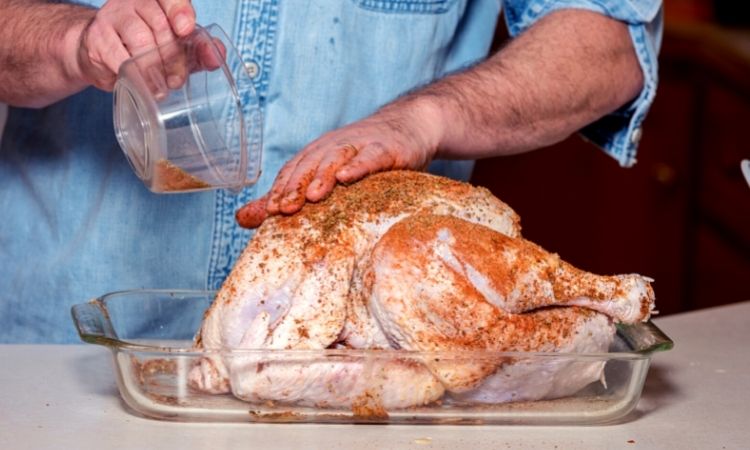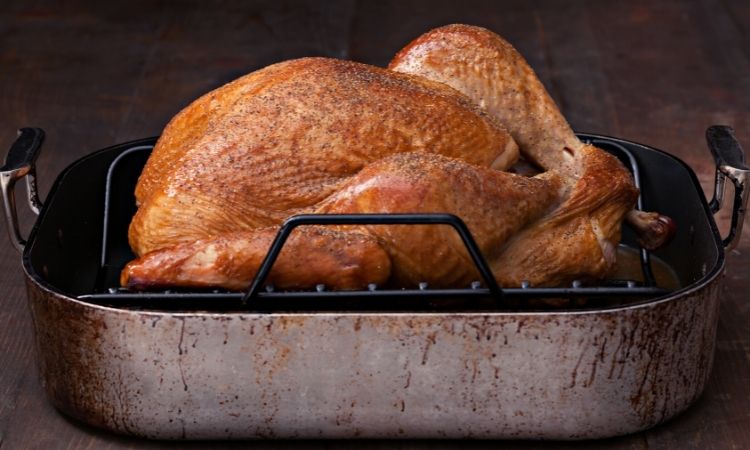Good turkey is the staple of the holiday meal. But, unfortunately, in many households, bad turkey takes its place.
So how can you ensure that your family avoids the bad ones? A simple way is to try a pellet grill smoked turkey this year.
Pellet grills are perfect for families who are used to grilling but also want to enjoy foods with smokey barbecue flavors.
And few main dishes take to smoking better than turkeys do. They absorb that smokey goodness well, and with the proper preparation, you can get the most delicious and moist holiday feast you’ve ever wanted.
Here’s a look at a few things to keep in mind if a pellet grill is part of your holiday turkey plans. Once you master this recipe, you may find yourself eating turkey all year round.
What Do You Need for Smoking a Turkey on a Pellet Grill?
If you already own a pellet grill, smoking a turkey on it is the next logical step in evolution. It’s the tastiest way to prepare the dish, and the pellet grill is probably the best tool out there to do it.
Here’s what you need:
Pellet Grill
Obviously, if you want pellet grill smoked turkey, you’ll need one of these superb grills. All proper pellet grills are exceptional at maintaining their temperatures for smoking recipes. The only caveat is that you’ll need a grill large enough to hold your bird. Of course, couples and small groups can opt for just a turkey breast.
Another great option for smoking a turkey is to use a vertical pellet smoker.
Drip Pan
When smoking a turkey, you can use a drip pan more like a baking dish. It’s a handy platform to move it in and out of the grill with. It will also help your bird retain some moisture, and best of all, it makes cleaning up easy after you’re done.
Another option is to put the turkey directly on the cooking grid, add some water to the drip pan, and then place it directly under the bird. You can use any type of dish for this — it just needs to fit inside your pellet grill and be strong enough to support the bird’s weight when moving it around (if you put the turkey on it). That’s where those disposable foil trays usually fail.
Turkey
It’s not quite as easy as walking into a grocery store and buying a turkey. There are a lot of choices. As a general rule of thumb, the least processed bird you can find will be the best. Unless you’re in a pinch for time, avoid pre-brined turkeys as these can be overly salty — and you can do better. More on that below.
When it comes to size, most families average around 1.5 pounds of turkey per person, including bones. So a six-person gathering should aim for a nine-pound bird.
Wood Pellets
The most common choices to go with turkey are hickory, cherry, or applewood pellets. The aim is to pick something light and fruity rather than something strong and overpowering. Remember, turkey is pretty mellow meat that will readily accept flavors. Depending on its size, you’ll be smoking your bird for eight hours or more. Make sure you have enough pellets on hand to cover it!
Check out our guide with Traeger and Pit Boss pellets to find some nice options.
Thermometer
It’s vital that you use a good-quality thermometer while smoking a turkey. Cooking time is more or less useless with such a big piece of meat. The only way to know your turkey is done is when the internal temperature in the thickest pieces of the meat reaches 165 degrees Fahrenheit.
The best thermometers have remote probes and programmable alarms. You can set them to 165 and see the temperature without even lifting the grill’s lid. That way, your grill won’t lose heat every time you check the meat’s temperature.
Seasoning
Review your recipe and make sure that you’ve got everything on hand. Simple recipes only have salt, pepper, extra virgin olive oil, and a few other staple ingredients. Special occasion recipes, on the other hand, might have some rarely used spices.
Don’t have a pellet grill or need an upgrade?
Check out our brand comparisons of Traeger vs Green Mountain and Traeger vs Pit Boss to find a quality product.
How Long to Cook a Turkey on a Pellet Grill?
A little planning goes a long way.
It doesn’t take much work or effort to make pellet grill smoked turkey, but it certainly requires days of preparation.
Each phase takes a long time, which means that a key component of the preparing phase is making a simple schedule. So, a far more critical question than how long do you let it cook is, “How long does it take from the moment I bring it home from the store?”
Most turkeys you find will be frozen solid, and since they’re so big, they can take three days or more to completely thaw in your fridge.
Of course, the best way to avoid this problem is to buy a fresh turkey — but that can be impossible to find in some areas.
Next, you may want to brine the turkey, which is a 12-hour process, at a minimum.
Finally, the day arrives, and it’s time to smoke your turkey
So how long will that take?
The general rule of thumb is that you should plan on 20 to 30 minutes for every pound of turkey.
A 10-pound turkey would require 3.5 to 5 hours, and a 15 pounder would need 5 to 7.5 hours.
The precise doneness is not measured by time, of course. You must cook your bird to an internal temperature of 165 degrees Fahrenheit. The time is just a rule of thumb for planning.
You can speed things up by raising the temperature on the grill but only to a certain extent. Raising the heat runs the risk of drying out the meat and losing some of the smokiness you’ve worked so hard to achieve!
How to Smoke a Turkey on a Pellet Grill
1. Preparing
Nearly all of us buy frozen turkeys at the supermarket. However, such a large piece of meat requires a bit of time to thaw — so planning is critical.
Give your bird at least three full days in the refrigerator to thaw. Nothing ruins the holiday quicker than realizing your turkey is still frozen solid on the morning of the feast!
2. Brining
Brining is optional but always recommended. There is simply no better way to add moisture and seasoning to such a large bird.

Brining means simply soaking the meat in saltwater for many hours, usually overnight. This gives the salt time to work its way deep into the meat, so even thick parts like the breast will be moist and evenly seasoned.
Should you buy a pre-brined turkey?
Some supermarket birds are pre-brined. If at all possible, you should avoid these. They may be a time-saver, but it gives you little control over the process as the chef.
On the other hand, brining is the perfect opportunity to add some flavor notes that will complement the entire meal. Plus, you can add a few goodies that will make the smoky flavors from your grill pop.
So how do you brine a turkey?
First, you’ll need a large enough container that you can submerge the entire bird in.
Here are three great options to consider:
- Soup Pot: If your turkey isn’t very big, you might be able to put it in a soup pot that you can place in the refrigerator.
- Cooler: Large coolers work very well for the purpose, plus they’ll keep the whole thing cool overnight.
- Brining Bag: Make things easy and order an affordable turkey brining kit from Amazon. The kit includes a brining mix and a bag that fits even a large turkey.
Next, make a brine by mixing water, salt, and whatever else you want to flavor the bird with. You can first boil the salt in a small amount of water to dissolve it properly.
You can use one cup of kosher salt (or coarse sea salt) for every gallon of water.
For a sweet kick, some chefs like adding molasses or brown sugar. Others like the zing of citrus, be it cut lemons or oranges.
Then, of course, you can’t go wrong with some holiday flavors like cloves, peppercorns, cider, garlic, or all of the above.
Once the salt has dissolved in a bit of hot water, mix it with a gallon or more of cold water in your bucket, cooler, brining bag. Make sure to keep it cold, as you want to keep your bird under 40 degrees Fahrenheit for the entire time it’s brining. Don’t make a comfy home for nasty bacteria — keep it cold.
Brining takes a minimum of 12 hours, but there’s nothing wrong with going a little longer.
Once the brine is finished, carefully remove the turkey, thoroughly rinse it off, and then pat it dry. Discard the brine and wash your bucket.
3. Seasoning
Move the turkey to your drip or roasting pan and begin prep for the grill.
There are two components to seasoning a turkey for smoking. On the one hand, you’ll want to coat the skin with fat to get that crispy and beautiful golden crust. On the other, you’ll want to add some seasoning for flavor.
Start by adding the fat. Nothing browns better than butter, but chances are the amount of butter you’d need to do the entire turkey would be enough to give Grandpa another heart attack.
So instead, opt for a 50/50 mixture of melted butter and extra-virgin olive oil. This will add buckets of flavor and brown beautifully, all while being significantly healthier.
Then season the meat. Use kosher salt and lots of fresh ground pepper — but the rest is up to you.

There are tons of commercially available turkey rubs on the market, not to mention countless web pages with DIY recipes. It’s best to experiment and find one your family likes.
Try having a lavish all-out recipe with lots of sugar and spices for holidays, and then keep it simple with salt and pepper for an ordinary weekend.
If you don’t know where to start, we recommend trying the excellent Chairman of the Bird Gourmet Turkey Rub.
4. Smoking the Turkey
Once seasoned, move the turkey to a preheated grill and start the magic!
You’ll want your grill rocking somewhere between 225 and 300 degrees Fahrenheit. Warmer temperatures will cook slightly faster, but they’re also more likely to dry out the meat, and you’ll lose some of the smokey goodness.
Be sure to insert the probe of your remote oven thermometer into the deepest meat of the breast.
Sure, you could use an instant-read thermometer in a pinch. But doing so would require lifting the lid to check — and remembering to check.
Instead, we recommend using an inexpensive remote-probe thermometer with a programmable alarm. Set the alarm to 165 degrees and sit back and wait for it to chime!

One of the beauties of smoking is that the process requires far less tinkering than a traditional roasting recipe. This is because the low temperature allows the meat to cook through without over-drying.
After the turkey is ready, remove it from the pellet grill and let it rest for at least ten minutes before serving.
How about stuffing and side dishes?
The low temperatures mean that any stuffing or vegetables would likely not cook well and will only add to your total cooking time. So for smoking, skip the stuffing.
If you want to cook up some sides at the same time, consider using the drip pan. You can add large chunked veggies, which will cook in the drippings. Since they’ll be away from the turkey, they’re less likely to affect the bird’s doneness.
And in the end, you’ll be left with an unbeatable, smoky, and rich broth!

Pellet Grill Smoked Turkey
Equipment
- Pellet Grill/Smoker
Ingredients
- 1 Whole Turkey 9 lbs Choose the appropriate size for your group (4 to 15 lbs)
Brining Liquid
- Salt 1 cup per each gallon of water
- Cold Water
- Flavorings e.g. Brown sugar, lemon, orange, cloves, peppercorns, garlic
For Basting
- 1 Part Butter
- 1 Part Extra Virgin Olive Oil
Seasoning Rub
- Kosher salt
- Fresh ground pepper
- Poultry rub seasoning of your choice
Instructions
- Completely thaw your turkey if it is frozen. This step can take up to three days in the refrigerator for large birds, so plan accordingly.
- Brine the turkey. Boil the brining ingredients in a small amount of water, and once the salt is dissolved mix with a gallon or more of ice water. Soak the bird in the solution for at least 12 hours.
- Rinse the turkey thoroughly and pat dry with paper towels. Set in your roasting or drip pan.
- Preheat your pellet grill/smoker to 225 degrees.
- Melt butter and the extra virgin olive oil together, then coat the skin of the turkey with the mixture.
- Season the turkey inside and out with your seasoning mixture.
- Place the turkey on the pellet grill and insert your thermometer probe in the thickest part of the meat. Set the alarm for 165 degrees Fahrenheit. Plan approximately 30 minutes for every pound of turkey. Avoid opennig the grill lid too often in order to maintain consistent temperatures.
- When the internal temperature reaches 165 degrees, remove the turkey from the grill and allow to rest at least ten minutes before serving.








